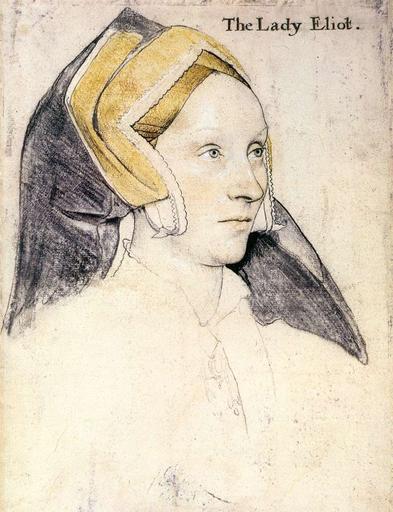MAKE A MEME
View Large Image

| View Original: | Holbein_Lady_Elyot.jpg (764x995) | |||
| Download: | Original | Medium | Small | Thumb |
| Courtesy of: | commons.wikimedia.org | More Like This | ||
| Keywords: lady elyot ladyelyot nobility gentry english gable hood gablehood portrait holbein 16th century 16thcentury tudors Portrait of Margaret à Barow, Lady Eliot. Chalk, pen and brush on pink-primed paper, 28 × 20.9 cm, Royal Collection, Windsor. Margaret à Barow (c. 1500–1560) was part of the humanist circle around Sir Thomas More. Holbein made this study, along with that of the sitter's husband, Thomas (right), whom she married in about 1522, for matching paintings now lost. Both drawings are strongly reinforced with Indian ink around the heads and headgear, a technique absent in the portrait studies of Holbein's first English period. Dating from the earliest stage of his second period in England, which started in 1532, the drawings are unusually well preserved, down to the white chalk heightening Lady Elyot's nose and forehead. The sitter wears a gable hood. After her husband's death in 1546, Lady Elyot married Sir James Dyer, Chief Justice of the Court of Common Pleas. Portrait of Margaret à Barow, Lady Eliot. Chalk, pen and brush on pink-primed paper, 28 × 20.9 cm, Royal Collection, Windsor. Margaret à Barow (c. 1500–1560) was part of the humanist circle around Sir Thomas More. Holbein made this study, along with that of the sitter's husband, Thomas (right), whom she married in about 1522, for matching paintings now lost. Both drawings are strongly reinforced with Indian ink around the heads and headgear, a technique absent in the portrait studies of Holbein's first English period. Dating from the earliest stage of his second period in England, which started in 1532, the drawings are unusually well preserved, down to the white chalk heightening Lady Elyot's nose and forehead. The sitter wears a gable hood. After her husband's death in 1546, Lady Elyot married Sir James Dyer, Chief Justice of the Court of Common Pleas. Portrait of Margaret à Barow, Lady Eliot. Chalk, pen and brush on pink-primed paper, 28 × 20.9 cm, Royal Collection, Windsor. Margaret à Barow (c. 1500–1560) was part of the humanist circle around Sir Thomas More. Holbein made this study, along with that of the sitter's husband, Thomas (right), whom she married in about 1522, for matching paintings now lost. Both drawings are strongly reinforced with Indian ink around the heads and headgear, a technique absent in the portrait studies of Holbein's first English period. Dating from the earliest stage of his second period in England, which started in 1532, the drawings are unusually well preserved, down to the white chalk heightening Lady Elyot's nose and forehead. The sitter wears a gable hood. After her husband's death in 1546, Lady Elyot married Sir James Dyer, Chief Justice of the Court of Common Pleas. portrait english gentry 16thcentury nobility tudors holbein gablehood ladyelyot | ||||